Study: Weight Loss and Wellness During COVID-19
The ongoing COVID-19 pandemic has pushed wellness to the front of people’s minds.
However, amidst constant public health messaging that encourages frequent hand washing and strict physical distancing, we’ve also seen another important message emerge: mental health matters too. In this uncertain time, health experts are more focused than ever on promoting behaviors that keep people happy, or at least sane, while self-isolating.
Influencers and news outlets, such as Glamour Magazine or Huffpost, have latched onto this fresh chance to promote self-care, self-forgiveness and – interestingly – a decreased focus on weight and weight loss (
So, are most Americans heading this advice and relaxing their routines, or are they instead using the extra at-home time to build healthy habits and foster wellness?
Summary of Findings
Phentermine.com conducted a survey of 1,000 American adults to find out how the COVID-19 outbreak has impacted individuals’ thoughts & actions related to wellness and weight loss.
Study highlights:
Most Americans Aren’t Focused on Weight Right Now
Nearly three-quarters of adults are either equally (32%) or less (40%) worried about weight loss now. With everything happening in the world, people have other things on their mind.
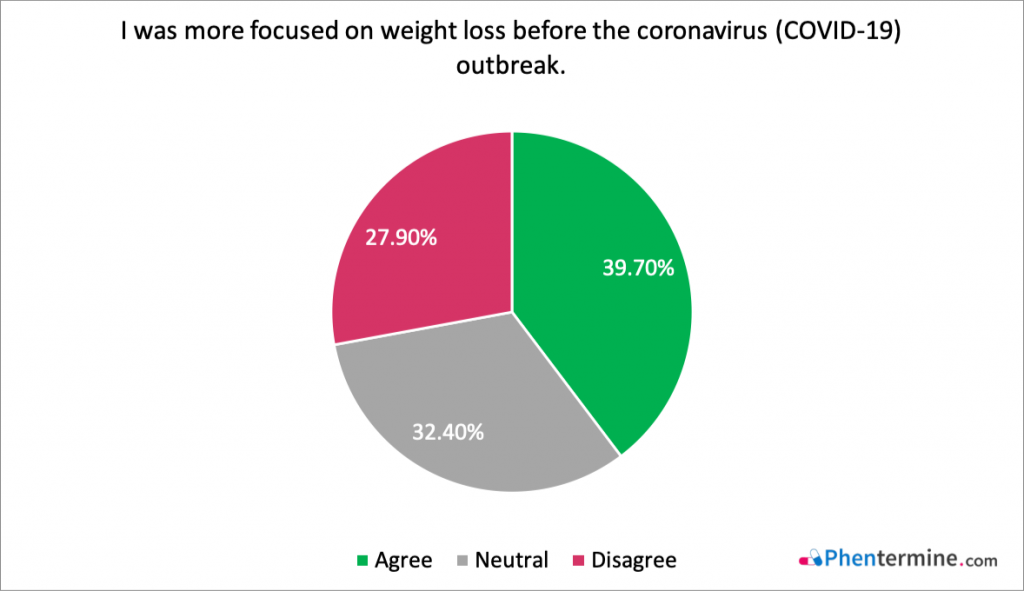
Respondents with an obese BMI were more likely than their normal weight counterparts to report a decreased interest in weight loss (45% vs. 34%, respectively).
“It’s hard to lose weight and even harder with all the added stress of COVID-19!”
“It has been harder to lose weight because I have been stress eating.”
“I want this to be over to continue my journey!”
Respondents’ take on weight loss during the pandemic.
While this discrepancy may simply stem from normal weight individuals being less focused on weight loss before the outbreak, it may eventually prove problematic that some overweight and obese individuals have largely relaxed long-term weight loss goals.
Due to rampant social pressure to be thin and attain a slim aesthetic, women, young adults and overweight individuals tend to be the most focused on body image and weight loss during normal times (
Despite the ubiquitous “quarantine 15” memes and body positive messaging, more than one in four adults are now more worried about weight loss than they were before COVID-19 hit. An increased interest in wellness, concerns about unintentional weight gain or simply having more time on their hands could all be responsible for this uptick in interest.
Is Weight Loss a Good Strategy to Stay Healthy?
“Weight control is important to a strong immune system and better health. all about lifestyle, diet and exercise.”
One respondent’s opinion on weight control and overall health.
Adults who maintain a healthy weight have better health outcomes overall, but the relationship between weight loss, obesity and immune function is complicated.
Overweight and obese individuals are more likely to suffer from chronic conditions like cardiovascular disease and type 2 diabetes, many of which can be managed or reversed with weight loss. Plus, vaccines are not as effective for the obese population because heavier patients are less likely to generate the appropriate (protective) antibody response (
Healthy habits often associated with weight loss – like regular exercise and a balanced diet – also independently boost immunity. Eating a diet high in fiber and antioxidants bolsters your body’s ability to fight disease, while eating too much sugar and fat (or just eating too much in general) decreases immune function. Likewise, engaging in moderate physical activity most days strengthens the immune system, but exercising too much or too little can have negative effects (
One small study from the 90s did, however, show that short-term immune function is inhibited during active weight loss (
COVID-19 Has NOT Worsened Most Americans’ Diets
Despite the nationwide flour shortages and food pics plastered across social media, almost half (49.7%) of survey respondents reported that their diet had not changed as a result of the current pandemic.
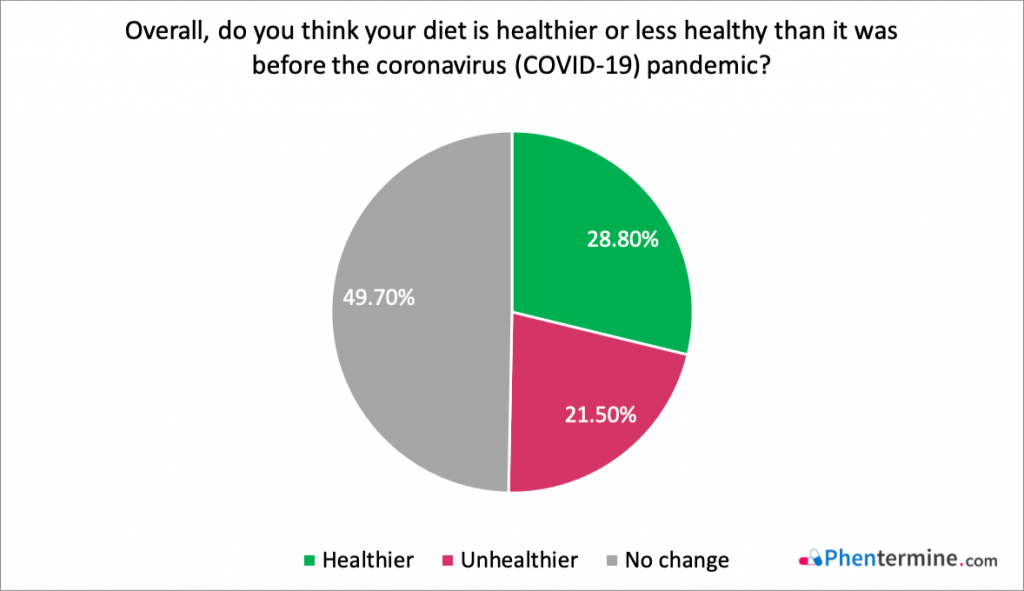
The remaining half (50.3%) of respondents did report a change in diet. Most of this half (28.8% of the total sample) said their eating habits have improved, while the rest (21.5%) said their diet was less healthy.
“I plan on eating healthier when I can go grocery shopping and find vegetables and fruit.”
The availability of certain food during the pandemic has a negative impact on this respondent’s diet.
Respondents with BMIs in the overweight or obese range were more likely than normal weight respondents to report an improvement in their overall diet quality. This might be based on the fact that currently, vices, such as fast food, are less accessible than before the COVID-19 outbreak.
Here are some of the most noteworthy changes to Americans’ eating habits:
1. Home-Cooked Meals Are Making a Comeback
The most common dietary change, according to survey respondents, has been cooking more meals at home (44.7%).
“Having more time at home gives me more time to cook healthy meals.”
One respondent’s reason for cooking her own meals with healthy ingredients.
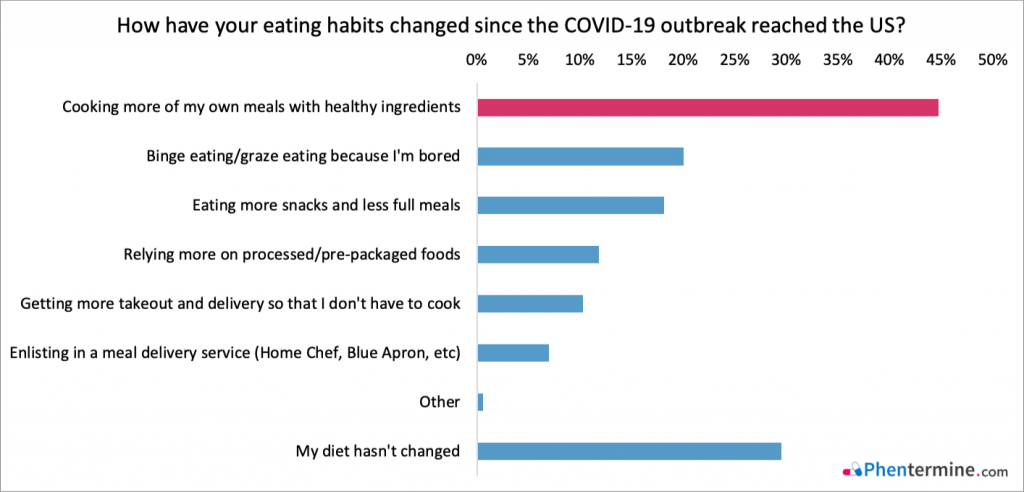
Many of these people (24.9% of the total sample) also report incorporating more fruits and vegetables into their daily meals.

This is great news because focusing on home-cooked meals and upping produce consumption are scientifically proven, time-tested strategies for weight loss and wellness. Individuals who have five or more home-cooked meals each week are more likely to maintain a healthy body mass index (BMI) and healthy fat percentage, as compared to people who eat fewer than three home-cooked meals per week (
People who cook at home are also more likely to eat fruits and vegetables, which provide a myriad of health benefits. Diets high in fruits and veggies may reduce risk of cardiovascular disease, plus certain micronutrients present in fruits and vegetables have been shown to boost immune function (
Young adults, especially, are cooking more at home (51.8% of 25- to 34-year-olds) since the outbreak of COVID-19. Older adults, on the other hand have not seen as dramatic of an increase, with only 35.5% of adults older than 54 saying they’re cooking more at home. This may be related to the fact that older adults were already more likely to cook at home before the pandemic (
Even if people aren’t losing weight at home during “shelter-in-place”, learning to cook and finding ways to eat more fruits and veggies are healthy long-term changes. If people maintain these beneficial behaviors after they return to normal life and start moving more, it’s very possible that we could see a positive (downward) change in average BMI.
2. Many of Us Struggle with Snacking More
The most common negative eating pattern reported by survey respondents was snacking or “grazing” more since the start of the pandemic (20%).
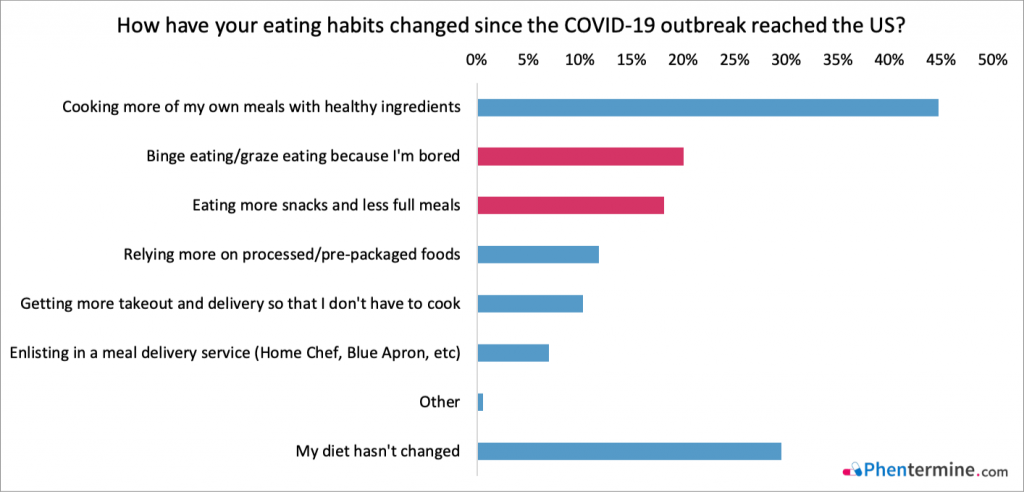
Snacking can be healthy when motivated by hunger, but many times we snack to cope with boredom, stress, anxiety, or other emotions, or because of laziness. This is confirmed by the comments of some of our respondents:
“It’s easy to revert to bad habits when bored”
The term “grazing” is often used to describe a mindless or uncontrolled snacking pattern that people engage in throughout the day, regardless of physical hunger. Grazing all day isn’t productive because it can lead to weight gain and/or gastrointestinal upset including nausea, bloating and constipation (
However, for adults who aren’t confident in their cooking skills, don’t have access to a kitchen, or simply choose not to prepare food at home, grazing may become the primary source of nutrition as “stay at home” orders persist and eating out becomes increasingly difficult.
3. Availability is Already Impacting Dietary Choices
Food availability was already impacting Americans’ dietary choices as well. Survey respondents commented that they were choosing different foods based on what was available at their local grocers, and wasn’t available at favorite restaurants.
“Things are harder to get at the stores!”
“Eating whatever is available on the shelves.”
Food availability is impacting dietary choices.
Even in early April, 11.8% of adults reported eating more canned/processed foods and 10.3% were ordering more takeout and delivery.
“Now i have to eat what is available because fresh food is hard to get here and I worry about the virus being on the fresh fruits and vegetables. The packaged and canned meats can be sanitized as well as the frozen and shelf foods.”
Besides in-store availability, sanitary precautions have an impact on dietary choices.

As the crisis continues, we expect further disruption to Americans’ diets. Lost income, decreased mobility and supply chain disruption are all likely to affect food supply, and therefore eating patterns, in the coming months (
Three in Four Americans Are Adding Self-Care to Their Routine
In addition to cooking more at home and adding more produce, people are also taking more time to focus on self-care and wellness.
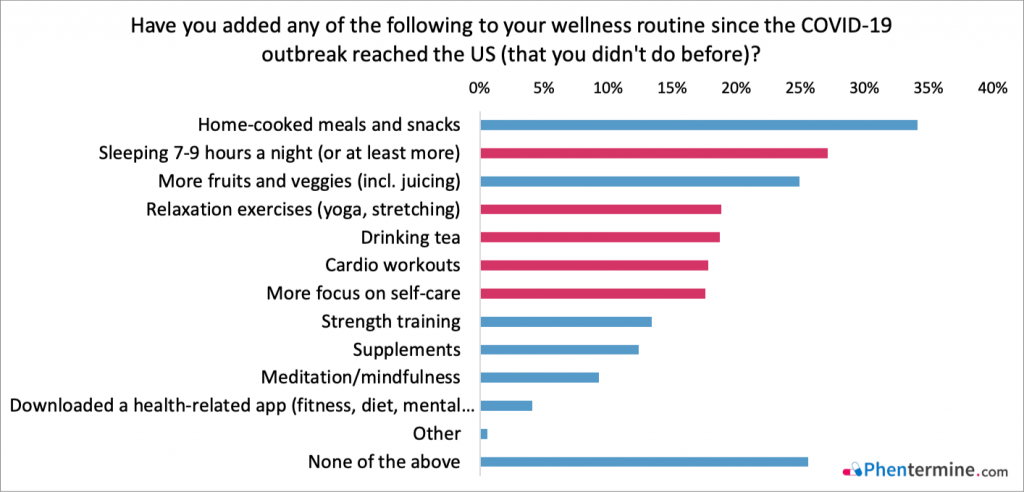
The most common change has been sleeping more, with 27% of respondents reporting a sleep schedule closer to the recommended 7-9 hours per night (
In fact, research shows that dieters who sleep 5.5 hours per night lose 55% less fat and significantly more “fat free mass” (muscle) than their counterparts who sleep 8.5 hours per night (
Other common additions to people’s routines included:
- Relaxation exercises, like yoga or stretching (18.8%)
- Drinking tea (18.7%)
- Adding cardio workouts (17.8%)
- Taking more time for self-care, in general (17.6%)
Some people are also turning to supplements (12.4%), strength training (13.4%) or meditation/mindfulness (9.3%) to stay healthy in the face of this unprecedented public health crisis.
The most notable demographic difference in wellness strategies was an inverse relationship between age and additional physical activity. In other words, younger adults are more likely than older adults to incorporate physical fitness (cardio and strength training) into their daily wellness routines.
Moreover, overweight and obese respondents were less likely than their normal weight counterparts to report physical activity (cardio or strength training) as a way of maintaining their wellness.
“With the extra time you’d think i’d be more willing to keep up with a workout regime but it’s been the complete opposite.”
A respondent’s struggle to maintain a workout routine at home.
Most of us walk about 5000 steps, or around 2-2.5 miles, per day when not in quarantine (
Conclusion
As the pandemic continues, Americans’ relationship with wellness will undoubtedly evolve. Stress related to job loss, economic decline and other hardships may take a toll on people’s health and weight.
Still, most adults aren’t worried about weight loss right now. Americans report that their diets are not significantly different than before the pandemic, but many of us have started cooking more at home. Most people have also adopted at least one new wellness-related habit as they take advantage of their extra time at home.
It will be interesting to see how this pandemic ultimately affects the weight and health of Americans. While some individuals will undoubtedly gain weight as a result of decreased physical activity, fewer food options and/or increased cortisol levels, others will probably lose weight due to prolonged periods of anxiety, economic hardship and/or food shortages.
Either way, this pandemic is almost certain to have far-reaching effects on Americans’ health, and potentially weight status, for several years to come.
For more information about this survey, or to inquire about republication of the data, please contact us at here or email us directly at contact@phentermine.com.
Survey Methodology
On April 5th, Phentermine.com polled 1,000 American adults to find out how the COVID-19 outbreak has impacted individuals’ thoughts & actions related to wellness and weight loss. Responses were collected online with the help of the survey platform “Pollfish.com”.
Disclaimer: this survey was conducted about three weeks after President Trump declared a state of emergency and when the US had only about 10,000 deaths. Many more people’s diets may be affected as the crisis continues.
Demographics
Gender Distribution
Of the 1,000 respondents, 56% were female and 44% were male.
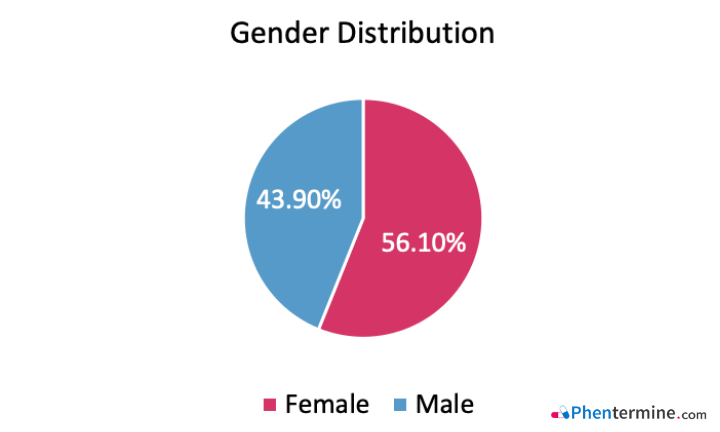
Age Composition
As far as age goes, the majority of respondents was in the 54+ range, followed by those between 25-44 years of age.

Residence
When looking at the residence of the respondents, 38% were based in Southern states, 22% in the Midwest, 20% in the Northeast and 20% in the West.
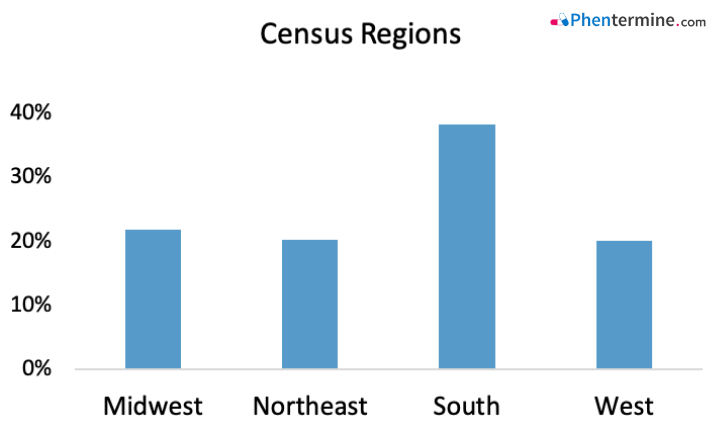
BMI Distribution
BMI scores were calculated for each respondent based on their height and weight. The big majority falls into the overweight/obesity range (67%) while 27% are considered as “normal weight” – ranges in accordance with guidelines from the NIDDK (
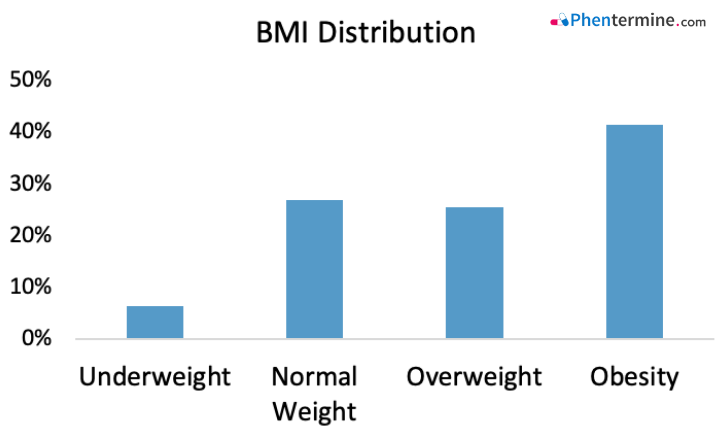
- Schallon, L., Schallon, L., Colón, A., & Garcia, A. (2020). Everyone Is Terrified of Getting “Quarantine Fat’ and Just Enough Already.
- Byrne, C. (2020). Stop Obsessing Over Quarantine Weight Gain And Cut Yourself Some Slack. Retrieved from
- Kashubeck-West, S., Mintz, L. B., & Weigold, I. K. (n.d.). Separating the Effects of Gender and Weight-Loss Desire on Body Satisfaction and Disordered Eating Behavior. Sex Roles, 53(7), 505–518. doi: 10.1007/s11199-005-7138-4
- Nieman DC, Nehlsen-Cannarella SI, Henson DA, Butterworth DE, Fagoaga OR, Warren BJ, Rainwater MK. Immune response to obesity and moderate weight loss. Int J Obes Relat Metab Disord. 1996 Apr;20(4):353-60. PMID: 8680463.
- Deivert, S. F., & Fleetwood, M. K. (2013). Obesity and the Immune System.
- Mills S, Brown H, Wrieden W, White M, Adams J. Frequency of eating home cooked meals and potential benefits for diet and health: cross-sectional analysis of a population-based cohort study. Int J Behav Nutr Phys Act. 2017 Aug 17;14(1):109. doi: 10.1186/s12966-017-0567-y. PMID: 28818089; PMCID: PMC5561571.
- USDA ChooseMyPlate. (2020). Nutrients and health benefits: Why is it important to eat vegetables?
- Gibson A, Edgar JD, Neville CE, Gilchrist SE, McKinley MC, Patterson CC, Young IS, Woodside JV. Effect of fruit and vegetable consumption on immune function in older people: a randomized controlled trial. Am J Clin Nutr. 2012 Dec;96(6):1429-36. doi: 10.3945/ajcn.112.039057. Epub 2012 Nov 7. PMID: 23134881.
- Porch. Cooking Nightmares.
- Freuman, T. D. (2014). How Grazing Affects Your Digestive Function.
- Wolf, Z. B. (2020). It’s time to talk more seriously about the food supply.
- National Sleep Foundation. (2020). How Much Sleep Do We Really Need?
- Nedeltcheva AV, Kilkus JM, Imperial J, Schoeller DA, Penev PD. Insufficient sleep undermines dietary efforts to reduce adiposity. Ann Intern Med. 2010 Oct 5;153(7):435-41. doi: 10.7326/0003-4819-153-7-201010050-00006. PMID: 20921542; PMCID: PMC2951287.
- National Sleep Foundation. (2020). Boost Your Health with Better Sleep.
- Santos-Longhurst, A. (2018). How Many Steps Do People Take Per Day on Average?
- Bumgardner, W. (2019). How Many Steps Are There in a Mile?
- National Institute of Diabetes and Digestive and Kidney Diseases. (2017). Overweight & Obesity Statistics.
Did you like the article?
Subscribe to our weekly newsletter and get our best weight loss tips straight to your inbox!
